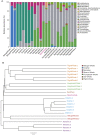A survey of the sperm whale (Physeter catodon) commensal microbiome
- PMID: 31309006
- PMCID: PMC6612419
- DOI: 10.7717/peerj.7257
A survey of the sperm whale (Physeter catodon) commensal microbiome
Abstract
Background: Mammalian commensal microbiota play important roles in the health of its host. In comparison to terrestrial mammals, commensal microbiota of marine mammals is mainly focused on the composition and function of skin and gut microbiota, with less attention paid to the health impact of bacteria and viruses. Previous studies on sperm whales (Physeter catodon) have affirmed their important phylogenetic position; however, studies on their commensal microbiota have not been published, due to difficulty in sample collection.
Methods: Here, we sequenced the metagenomes of blood, muscle and fecal samples from a stranded sperm whale using the BGISEQ-500 platform. We compared the diversity and abundance of microbiomes from three different tissues and tried to search pathogenic bacterial and virulence genes probably related to the health of the sperm whale. We also performed 16S rDNA sequencing of the fecal sample to compare to published gut metagenome data from other marine mammals.
Results: Our results demonstrated notable differences in species richness and abundance in the three samples. Extensive bacteria, including Enterococcus faecium, Fusobacterium nucleatum, Pseudomonas aeruginosa, Streptococcus anginosus, Streptococcus pneumoniae, and Streptococcus suis, and five toxigenic Clostridium species usually associated with infection, were found in the three samples. We also found the taxa composition of sperm whale gut microbiota was similar to that of other whales, suggesting co-evolution with its host. This study is the first report of the sperm whale gut microbiome, and provides a foundation for the pathogen detection and health assessment of the sperm whale.
Keywords: Commensal microbiome; Pathogentic microorganisms; Sperm whale.
Conflict of interest statement
The authors declare there are no competing interests.
Figures



Similar articles
-
Microbial diversity and structure in the gastrointestinal tracts of two stranded short-finned pilot whales (Globicephala macrorhynchus) and a pygmy sperm whale (Kogia breviceps).Integr Zool. 2021 May;16(3):324-335. doi: 10.1111/1749-4877.12502. Epub 2020 Dec 2. Integr Zool. 2021. PMID: 33174288 Free PMC article.
-
High diversity and unique composition of gut microbiomes in pygmy (Kogia breviceps) and dwarf (K. sima) sperm whales.Sci Rep. 2017 Aug 3;7(1):7205. doi: 10.1038/s41598-017-07425-z. Sci Rep. 2017. PMID: 28775301 Free PMC article.
-
Occurrence of anthropozoonotic parasitic infections and faecal microbes in free-ranging sperm whales (Physeter macrocephalus) from the Mediterranean Sea.Parasitol Res. 2018 Aug;117(8):2531-2541. doi: 10.1007/s00436-018-5942-3. Epub 2018 Jun 1. Parasitol Res. 2018. PMID: 29858939
-
Lifestyle alters GUT-bacteria function: Linking immune response and host.Best Pract Res Clin Gastroenterol. 2017 Dec;31(6):625-635. doi: 10.1016/j.bpg.2017.09.009. Epub 2017 Sep 6. Best Pract Res Clin Gastroenterol. 2017. PMID: 29566905 Review.
-
The Types and Proportions of Commensal Microbiota Have a Predictive Value in Coronary Heart Disease.J Clin Med. 2021 Jul 15;10(14):3120. doi: 10.3390/jcm10143120. J Clin Med. 2021. PMID: 34300286 Free PMC article. Review.
Cited by
-
A Preliminary Comparison on Faecal Microbiomes of Free-Ranging Large Baleen (Balaenoptera musculus, B. physalus, B. borealis) and Toothed (Physeter macrocephalus) Whales.Microb Ecol. 2022 Jan;83(1):18-33. doi: 10.1007/s00248-021-01729-4. Epub 2021 Mar 21. Microb Ecol. 2022. PMID: 33745062 Free PMC article.
-
Taxonomic composition and functional potentials of gastrointestinal microbiota in 12 wild-stranded cetaceans.Front Microbiol. 2024 Aug 29;15:1394745. doi: 10.3389/fmicb.2024.1394745. eCollection 2024. Front Microbiol. 2024. PMID: 39268538 Free PMC article.
-
Streptococcal Infections in Marine Mammals.Microorganisms. 2021 Feb 10;9(2):350. doi: 10.3390/microorganisms9020350. Microorganisms. 2021. PMID: 33578962 Free PMC article. Review.
-
Metagenomic Insights Into the Role of Gut Microbes in the Defensive Ink "Tsunabi" of Physeteroid Whales.Ecol Evol. 2025 Aug 8;15(8):e71910. doi: 10.1002/ece3.71910. eCollection 2025 Aug. Ecol Evol. 2025. PMID: 40785991 Free PMC article.
-
Fecal and skin microbiota of two rescued Mediterranean monk seal pups during rehabilitation.Microbiol Spectr. 2024 Jan 11;12(1):e0280523. doi: 10.1128/spectrum.02805-23. Epub 2023 Dec 12. Microbiol Spectr. 2024. PMID: 38084980 Free PMC article.
References
LinkOut - more resources
Full Text Sources

